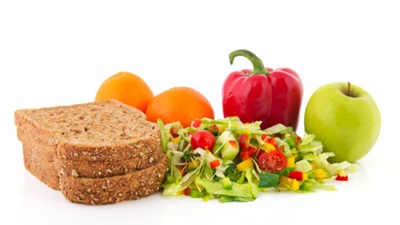
The processed and fast foods that make up the typical North American lifestyle put eating into a box, but stepping out of that box could mean you’re actually eating healthy. But, when society controls the masses, it also pulls the strings when it comes to promoting diet fads and techniques.
There are diets that focus primarily on weight loss, others on calorie intake, while others require you to detox, juice, or remove gluten, dairy, or carbohydrates.
However, the smartest advice I’ve received about nutrition is to eat healthy without worrying about following every hard-bent rule, and instead make positive steps toward your healthy eating lifestyle. When you worry, it puts an unhealthy strain on your mentality and your body, defeating the purpose of your intended healthy eating habits.
The Thrive Diet echoes this sentiment. This long term healthy eating lifestyle focuses on providing you with physical and mental benefits. It’s known to help reduce stress, by not achieving perfection, but by making progress with your healthy eating habits.
The diet is ultimately plant-based vegan, structuring meal plans around whole foods such as vegetables, fruits, legumes, grains, nuts, and seeds. The Thrive Diet is a holistic approach for high-performance athletes, vegans or vegetarians, while changing people’s mental capacity of what food does for your body.
The Thrive Diet brand is derived from the mind of former Canadian professional ironman triathlete and vegan advocator, Brendan Brazier. He is the bestselling author of The Thrive Diet (2008), Thrive Fitness (2009) and Thrive (2011). Brazier is also a recognized performance nutrition consultant and formulator of the whole food nutritional product line, Vega.
The Thrive Diet works for Brazier, who adopted the vegan lifestyle at age 15. He is a two-time Canadian 50-kilometer Ultra Marathon Champion. Can the Thrive Diet work for you as well?
The Thrive Diet isn’t just about eating whole foods exclusively; as it provides a clear and simple structure to maintain this long term platform. Here is what you need to know to get started with the Thrive Diet.
Eat High-Net Gain Foods
The cornerstone of the Thrive Diet is eating high-net gain foods, which are dense in nutrients. How do you identify high-net gain foods? These foods are usually bright or intense in color, and would include dark greens such as spinach or kale. Food in this diet should be whole, unprocessed, and preferably raw or cooked at low temperatures.
Recalibration Produces More Energy
Expect to practice recalibration within the Thrive Diet, where you reduce the amount of stimuli needed to gain energy. This helps you change your body’s perception of food.
When you eliminate stimulating foods from your diet, such as refined starches, carbs and sugars, your body becomes ready to receive the health benefits and energy from the healthier whole foods.
A possible side effect of this recalibration is tiredness, and possibly irritability, because your body has to adjust for a few days from the elimination of stimulants.
What You Can Expect to Eat
The Thrive Diet has a 12-week meal plan guide, with each day consisting of breakfast, a morning snack, lunch, an afternoon snack, dinner, and an after-dinner snack. This frequent eating allows you to maintain your energy, while you also consume less food overall.
Whole Foods
The Thrive Diet explores whole food that you might know about—and also food that you will learn about. The diet includes leafy greens, fibrous greens, starchy vegetables, legumes, seeds, pseudo-grains (seeds often referred to as grains), fruits, oils, nuts and grains.
Spinach and chickpeas you will recognize, however, amaranth and dinosaur kale may be new to your vocabulary. As you’ll learn, your food is a constant education.
Next-Level Foods
You will also be introduced to foods that go above and beyond any standard healthy diet. These foods are coined “next-level foods” because they are easy to digest, have a neutral or high pH, help reduce inflammation, boost the immune system, and speed up your recovery. Examples of these foods are chlorella, coconut, green tea, and maca.
Meals
Everyday staples of the Thrive Diet include various large green salads, nutrient-rich smoothies, and raw homemade energy bars.
The salads will contain chlorophyll, which are high in fiber and minerals, and are also topped with cold-pressed oils that provide essential fatty acids and antioxidants. Brazier suggests nine smoothie and eight energy bar recipes, which are simple and easy to make.
The Health Benefits of Thriving
There are several noticeable health benefits of practicing the Thrive Diet, including weight loss, better sleep quality, less joint inflammation, stable mental clarity, reduce cholesterol level, gain bone strength and improve your skin quality.
You can also expect to eliminate your junk food cravings and your need for stimulants such as caffeine or carbohydrates. After your exercise routine, you will also notice your recovery time is quicker, and you can even build leaner muscle tissue.
If you’re interested in Thriving yourself, visit Brazier’s affiliated web sites My Vega and Thrive Forward for recipes and additional information.
Diets are fads, but when you stick to a diet, it’s a lifestyle, especially when healthy eating is your goal.
The Thrive Diet proves that a plant-based whole foods regime works; however, it is dependant on actually implementing it as part of your life. Vegans all around the world have successfully proven that eliminating certain foods such as meat, eggs and dairy can be beneficial to your health.
The Thrive Diet changes how you perceive food, and for the right reasons.
Sources:
“About Brendan Brazier,” Vega web site; http://myvega.com/team/brendan-brazier/.
Brazier, G., The Thrive Diet: The Whole Foods Way to losing weight, reducing stress, and staying healthy for life (Toronto: Penguin Books Ltd., 2007), 1-6, 34,88-91, 286.
“How to Identify Nutrient Dense Foods,” Vega web site; http://myvega.com/vega-life/vega-blog/how-identify-nutrient-dense-foods/#.UlKlPiS-44A.













